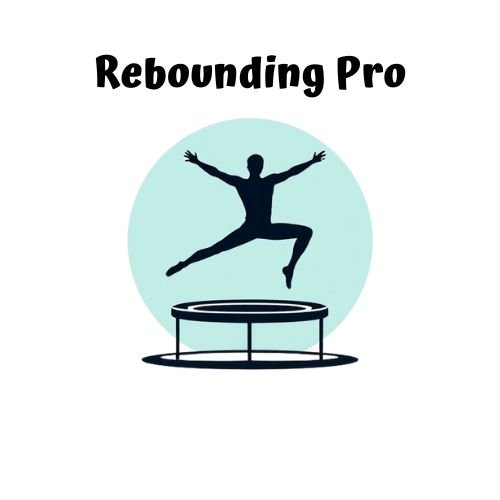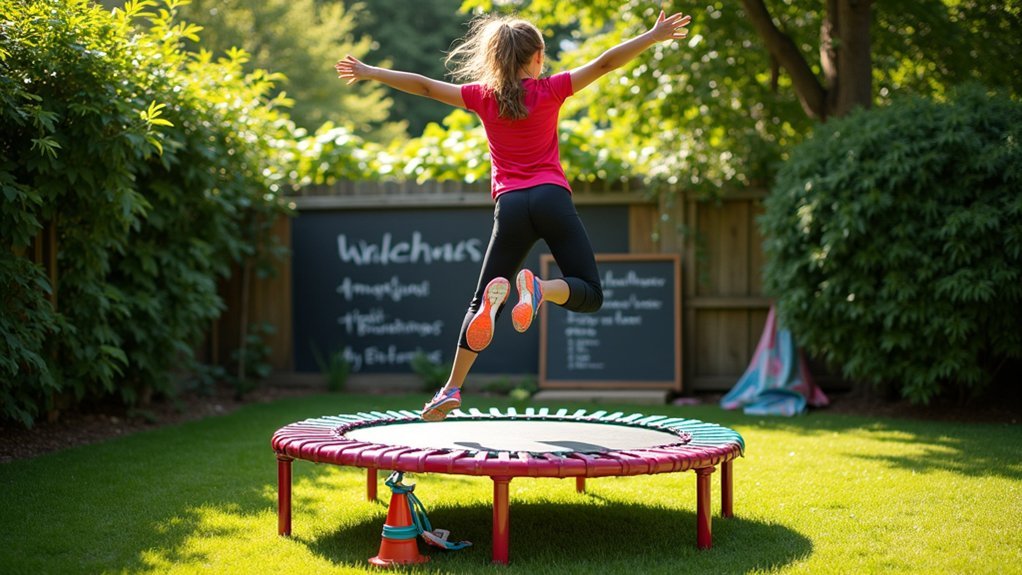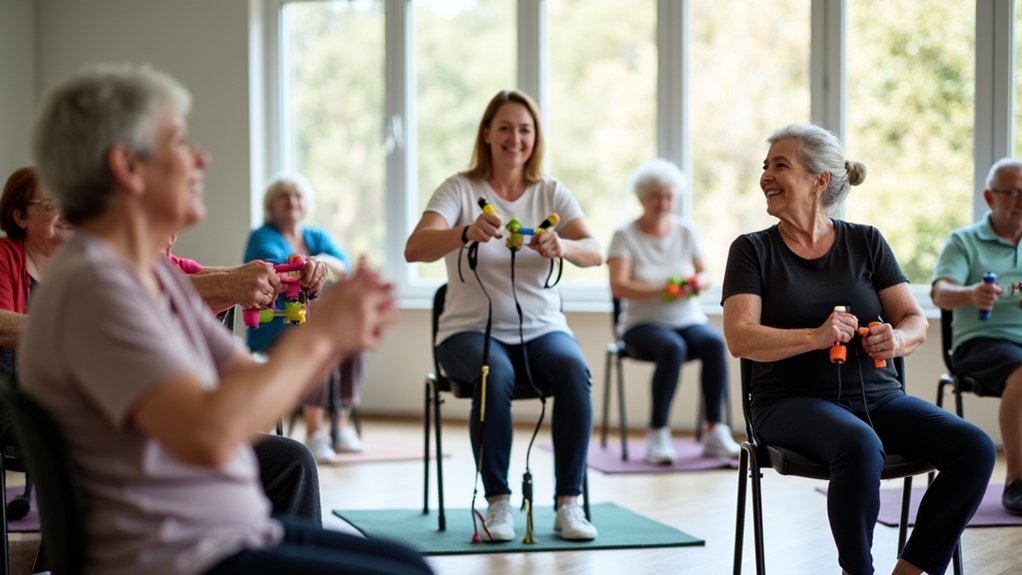Mini trampolines offer exceptional balance training with minimal joint impact. Try these five essential drills: single-leg bounces with gradual height increases, side-to-side steps for lateral stability, gentle marching in place (perfect for beginners), seated rotations to engage your core, and dynamic knee drives while maintaining stability. For seniors, always hold onto a stable surface when starting out. These exercises not only improve balance but also enhance coordination and reduce fall risk in everyday activities.
Core Stability Balance Challenge

While traditional balance exercises often focus on stationary positions, using a mini trampoline creates a dynamic environment that dramatically enhances your core stability training. The unstable surface activates your deep stabilization muscles more effectively than solid ground, improving both balance and posture.
You’ll find this approach particularly beneficial because it’s low-impact, reducing stress on your joints while still delivering impressive results. Begin with short 10-minute sessions, gradually progressing as your stability improves.
Try a mix of seated rotational movements, standing balance drills, and lying exercises to challenge your core from multiple angles. Practice single-leg bounces to further develop balance and stability while preventing potential falls.
What makes mini trampoline training so effective is its versatility—you’re simultaneously improving cardiovascular fitness, enhancing agility, and strengthening your core stabilizers in one efficient workout.
Single-Leg Rebounding Progressions
Single-leg rebounding represents the next step in your mini trampoline training journey, challenging your balance in ways that two-legged exercises simply can’t match.
Start with basic single-leg bounces, focusing on core engagement to maintain stability.
Master the foundation first: engage your core while single-leg bouncing to build essential stability.
Once comfortable, progress to knee drives by lifting one knee while bouncing on the opposite leg. Then advance to kicks that engage your glutes and hamstrings. For optimal results, keep your hips squared throughout all exercises to ensure proper muscle activation and prevent potential injuries. Gradually increase bounce height and incorporate directional changes to improve agility.
For safety, choose a trampoline with arched legs and elastic bungees. Always warm up before starting and stretch afterward.
You can intensify workouts by adding ankle weights or using music to maintain energy.
These low-impact exercises strengthen your core and legs while dramatically improving balance—all while protecting your joints.
Dynamic Movement Balance Drills

Taking your mini trampoline workout to the next level means incorporating dynamic movement drills that challenge your stability in multiple directions.
Try channeling your inner surfer with side-to-side steps that improve lateral stability while engaging your core muscles.
Combine breathing techniques with your movements to support lymphatic circulation as you perform these dynamic exercises:
- Practice “surfer movements” by bending knees and shifting weight as if riding waves, engaging core stabilizers
- Add arm extensions while performing twisting jumps to enhance coordination and full-body balance
- Integrate high-intensity jumping followed by controlled landings to improve cardiovascular strength
- Challenge yourself with dynamic leg switches, alternating feet rapidly during rebounds to boost agility
For maximum core activation, keep your feet positioned wide while performing alternating side pushes to strengthen oblique muscles and improve rotational stability.
Senior-Friendly Balance Exercises
As we age, maintaining balance becomes increasingly important for overall health and independence. Your mini trampoline offers a supportive surface for practicing balance exercises with reduced joint impact.
Begin with simple movements like marching in place while holding onto a chair or wall for support. As you gain confidence, try single-leg stands, starting with just a few seconds on each foot. Remember to wear comfortable shoes with good traction.
Start with basic motions while supported, gradually advancing to single-leg balance exercises. Always wear proper footwear for stability.
For strengthened stability, incorporate gentle toe taps around the trampoline’s perimeter and heel-to-toe walking across its surface. Regular exercise is crucial since it reduces fall risk for seniors, which is a leading cause of injury and death in Canada and North America. Always exercise in a well-lit area free from obstacles.
Start slowly and progress gradually. You’ll notice improved confidence and stability as you consistently practice these exercises, reducing your fall risk and enhancing your ability to maintain an active lifestyle.
Accessory-Enhanced Balance Training

While a mini trampoline provides an excellent foundation for balance work, incorporating specialized accessories can dramatically intensify your training and accelerate results.
These tools challenge your proprioception and neuromuscular systems in ways that simple bouncing can’t match.
Try integrating these accessories into your routine:
- Place a wobble cushion on your trampoline for single-leg stances while lightly bouncing to target ankle stability.
- Attach resistance bands to handles for lateral resistance during squats or lunges.
- Use ankle weights during basic bounces to increase strength demands while improving joint stability.
- Incorporate a stability ball for seated bounces that increase core activation by 20-30%.
Functional training with accessories on your mini trampoline improves real-world movement capabilities and reduces the risk of everyday injuries.
Always begin with controlled progressions and consider using a spotter for advanced combinations to guarantee safety.
Frequently Asked Questions
How Long Should I Practice Trampoline Balance Drills Daily?
Start with 5-10 minutes daily to build coordination. You’ll want to gradually increase to 15-20 minutes as you improve. Aim for 30 minutes total daily, but you can split this into shorter sessions to prevent fatigue.
Can Mini Trampoline Balance Exercises Help With Vertigo Symptoms?
Yes, mini trampoline balance exercises can help with vertigo symptoms. You’ll stimulate your vestibular system, enhance proprioception, and build core strength—all potentially reducing dizziness through gradual exposure to controlled movement.
Is It Safe to Perform Balance Drills During Pregnancy?
Balance drills during pregnancy aren’t generally recommended due to your shifting center of gravity and increased fall risk. You’re better off choosing low-impact exercises that don’t challenge your balance, especially in later trimesters.
Will Trampoline Balance Work Improve My Athletic Performance in Sports?
Yes, trampoline balance work will improve your athletic performance. You’ll gain better coordination, stronger core muscles, enhanced stability, and improved reaction time—all essential skills that transfer directly to your sports activities.
Can Children Benefit From Mini Trampoline Balance Training?
Yes, your child will gain significant benefits from mini trampoline balance training. They’ll develop stronger core muscles, improved coordination, enhanced spatial awareness, and better cognitive function while having fun bouncing through structured activities.
In Summary
Your mini trampoline isn’t just for cardio—it’s a powerful balance training tool. By incorporating these five drill categories into your routine, you’ll strengthen your stabilizing muscles, improve proprioception, and enhance overall coordination. Whether you’re a senior focusing on fall prevention or an athlete refining your performance, you’ll notice improvements in daily activities and sports. Start with basics, progress gradually, and you’ll reap the benefits of better balance.





Leave a Reply